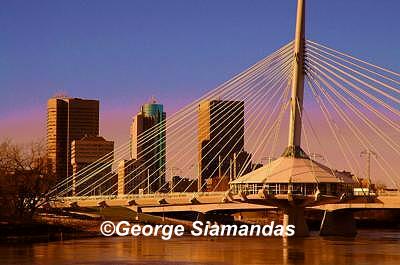
The Day They Closed Portage and Main
by George Siamandas
On February 24, 1979 the Underground Concourse at Portage and Main was officially opened to the public by Mayor Robert Steen. From that day on pedestrians have been barred from crossing at the famous corner of Portage and Main.
The concourse had been envisioned at the time of the building of the Richardson Building in 1964, and its concourse level was built in the early 1970s with a knock out panel for a future connection. Metro Winnipeg planners of the day felt that the increasing numbers of pedestrians and cars would interfere with one another more and more as the corners were developed. It was also the intention to realize that long standing Winnipeg dream of a weather protected downtown pedestrian walkway. Bernie Wolfe who was a Metro politician attributes the credit for the concourse to Earl Levin who used to be Metro's Chief Planner in the 1960s.
It was quite an engineering feat in that thirty manholes and 120 pipes, tunnels and tubes had to be relocated. All the underground work was done without interfering with traffic above. And it could only have been built after the Floodway was completed, otherwise it would have been prone to flooding.
At the time it was being planned there was small debate and virtually no opposition. Opinion studies done by Streets and Traffic dept the week after it was opened showed high public support for the project at about 80%. But soon it was discovered that it was not accessible by the handicapped and public demands were made to add elevators. To dramatize the issue, Councillor Joe Juken marched illegally over the barriers in 1979. Others like Nick Ternette have also walked across illegally in 1986 and 1995.
There is a lot of consensus that Portaeg and Main should be opened. Most of the general public would like to see it opened during the summer months. After all it is a national landmark. Mayor Susan Thompson has made a commitment that by Jan 1, 1998 she will have the intersection open well in advance for tourists coming to the 1999 Pan Am Games. Tourists who come to Winnipeg who had an image of the famous corner cannot believe that they cannot cross at the street.
Three of the four property owners at the corner have no objections, and the Downtown Biz and the Exchange Biz are for opening it. CentrePlan also has proposals to reopen Portage and Main.
Only one property owner, Trizec, is against it. Bernie Wolfe also remains an adamant opponent of reopening along with the City's Streets and Traffic Department. A 1991 study showed accidents are down 50% with twice the traffic. Also a wind study conducted at the corner in the late 1980s suggests that on windy days, it may be "too dangerous" for pedestrians, now that there are three office towers there.
A compromise would recognize the need to keep traffic moving at peak times and the intersection might only need to be open part of the time. People that have looked at the issue believe that you could open up the crossing between the Richardson Building and the Bank of Montreal with minimal upset to the traffic.
The Richardson corner has the best potential to become a wonderful plaza. The Richardsons could get the ball rolling by considering a major upgrading of their plaza to create a vibrant public space.
The key would be to have some activity, entertainment, an outdoor cafe, a place where the public could sit and watch people and traffic. And to do it with some shelter from the wind and with good outdoor design like lighting and benches.
Trizec and its merchants would also have to be persuaded that they will not lose customers. Attracting more people downtown might even improve their business.

1 comment:
An alternative proposal might be to install what is called a "Barnes Scramble" at the intersection. A Barnes Scramble means that you have 3 phases of lights instead of 2, whereby Pedestrians are not allowed to cross at the first two, but the third one, all traffic from both directions is stopped and the pedestrians are allowed to cross in any direction (including diagonally) that they wish.
They are being used increasingly around the world in dense cities as a solution to the Pedestrian/Traffic mix, with Toronto most recently proposing the idea for Bloor and Yonge, as well as Bay and King.
Post a Comment